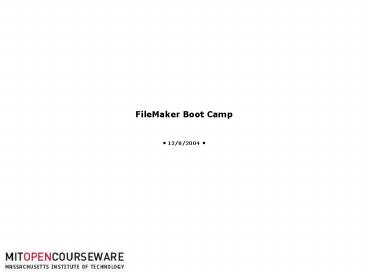FileMaker Boot Camp - PowerPoint PPT Presentation
1 / 16
Title: FileMaker Boot Camp
1
FileMaker Boot Camp
- 12/8/2004
2
What is a database, anyway?
- Literally, a collection of data. The information
weve collected over the past two years is a
database. It just happens to be stored in a
FileMaker system. Most data is in some sort of
tabular form. - What is FileMaker then?
- A database management systemallows for the
manipulation of data in the system. - A rapid application development toolallows for
quick, easy changes to the system.
3
Why FileMaker?
- Networking, networking, networking. Plays nice
with PC and Mac, uses TCP/IP. - Plays nice with other tabular data (Excel,
Tab-delimitated text files, CSV files) - Flexible ways to get data back out.
- Combines multiple data sets (tables) via defined
relationship rules.
4
Defining some terms
- Server A machine that hosts FileMaker files for
networked use (using a program called FileMaker
server). - Client A local copy of FileMaker that is being
used to access FileMaker Server - File The actual .fp5 file stored locally or on a
server. - Table A data set about a defined entity in
tabular form. (Note In FM 5.5, each file
contains one and only one table.) - Field A defined data element (an attribute of
the entity, if you speak database), usually
encountered as a data entry box on a layout. - Record A set of data about a particular defined
entity within a table. - Key Special field containing unique serial
number that identifies each record. - Layout A user view within a file that simplifies
(we hope) the manipulation of data. - Mode The data manipulation operational state of
the FileMaker client.
5
OCWs implementation
6
OCWs implementation(what you need to know)
7
Logging into FileMaker
- Start FileMaker on the desktop.
- (Insure in EditgtPreferencesgtApplication, Network
Protocol is set to TCP/IP. If it isnt, set
it, quit and restart FileMaker.) - In initial dialogue box, select Open an existing
file. - Click Hosts button.
- (Select Specify Hosts In the Hosts dialogue
box, type newohana.mit.edu and check the
permanently add button. Click the Open
button and go to step 8.) - Highlight newohana.mit.edu in the bottom window
of the Hosts dialogue box. A list of FileMaker
files should appear in the top window. - Select desired start file and click the open
button. - Enter password.
8
Navigation in FileMaker
To move between layouts
To move between records
To move between files
9
Navigation in FileMaker
To change modes
10
More about modes
- What are you trying to do?
- Browse Move through a set of records (the
default state). (Enter via A/C-B) - Add new records. (A/C-N)
- Omit records from the found set. (A/C-T)
- Delete existing records (A/C-E)
- Find Locate a record or set of records. (Enter
via A/C-F) - Set search criteria
- Preview Previews a print function. (Enter via
A/C-U)
11
Adding and deleting records
Add record
Do not use!
Delete record
Note Deletions are cascading.
12
Still more about modesfinding, sorting and
manipulating records
- To find a set of records
- Enter find mode (A/C-F)
- Enter criteria in appropriate fields
- Logical operators (lt,gt,, etc.) can be used
- Multiple find requests can be created (A/C-N)
- Records can be omitted from the find using the
Omit checkbox - Order of requests is important!
- What if the find isnt right?
- Use RecordsgtgtModify last find function (A/C-R)
to recall last find request. - Change find to work.
- What if even the best find returns unwanted
records? - Use RecordsgtgtOmit Record function to omit
(hide, not delete) unwanted records. (A/C-T) - Sometimes easier to search for what you dont
want. - Find what you dont want, then use RecordsgtgtShow
Omitted function to pull up hidden records.
13
Working with a found set
Records menu
Total records
Found records
Sort status
14
Sorting a found set
- RecordsgtgtSort brings up sort dialogue box.
- Select criteria and hit Sort.
Fields to choose from
Fields chosen
Sort type
15
Navigation within the OCW system
16
Whodunnit?
- Steve architecture and system administration
- Debi Fuchs, Aptworks Consulting implementation
and troubleshooting - Bill Server and desktop support































